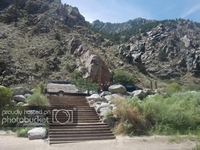I got a lot done today.
I adjusted the valves. Twice. After doing it the first time I realized I'd used the spec for mm instead of inches. Its pretty easy to do it with the engine on the bench, but I still had to bend the end of the feeler gauge to 90 degrees. I don't think I'd like to do it on the bike very often.
All buttoned up and ready to install the mechanical advnce, the points plate and the points.
First I cleaned all the parts with WD-40.
I had new points cover, hardware and points.
Adjusted and ready to go. I had to call Pat from the XL forum to interpert the manual for me because I wasn't sure what a points slipper was. Its the part that rubs on the end of the camshaft. It was pretty easy to do once I realized there were marks on the points plate and the cylinder head to line it up and marks on the points and end of the camshaft to set the gap.
The plastic coating had come off this cable guide. I used heat shrink and it looks pretty good.
I used cardboard to keep from scratching the frame when I installed the engine. I just picked it up and set it into the frame while Katherine installed the lower front and rear motor mount bolts. Then it was just a matter of installing all the hadware.
All finished. The carb was a **** to mount. I finally settled on attaching the throttle and choke cables before installing it. I also had to remove the air box to get everything to line up.
Once I got everything hooked up the throttle wouldn't return to shut by itself. Then I remembered I put a NOS throttle and kill switch on the bike and didn't lube the inside. Once I did that it worked fine.
Then I noticed it was leaking oil--and I hadn't even put oil in it yet! Upon investigation I found that I hadn't put the oil drain plug back in. The original was so bunged up I ordered a new one and never installed it.
I'll need to repaint and reinstall the exhaust system this week and hopefully I can see if it'll run next weekend.
I still need to relace the wheels. I'm going to fabricate or buy a stand in the next week. While I have the rims apart, I'll repaint the hub. Once the rims are relaced I'll install the new tires and I'll be mostly done. I have NOS speedometer with .1 miles on it and as soon as I find a tach I'll install them.
I'm really looking forward to getting it on the road. It's been a long time since I've riden a dirt bike.

 Feel free to hang out and lurk as long as you like. However, we would like to encourage you to register so that you can join the community and use the numerous features on the site. After registering, don't forget to post up an introduction!
Feel free to hang out and lurk as long as you like. However, we would like to encourage you to register so that you can join the community and use the numerous features on the site. After registering, don't forget to post up an introduction!


I can hardly wait to see it in front of a FM sign. Way to go.

 Love the Ohlins shocks!
Love the Ohlins shocks!
 Thanks again, look forward to the SL100.
Thanks again, look forward to the SL100.
Maybe you could bring the bike to a RTE sometime and we could buy you lunch.
Thanks again, look forward to the SL100.


